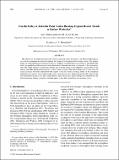| dc.contributor.author | Sheshadri, Aditi | |
| dc.contributor.author | Plumb, R. Alan | |
| dc.contributor.author | Domeisen, Daniela I. V. | |
| dc.date.accessioned | 2014-09-24T17:17:15Z | |
| dc.date.available | 2014-09-24T17:17:15Z | |
| dc.date.issued | 2014-02 | |
| dc.date.submitted | 2013-10 | |
| dc.identifier.issn | 0022-4928 | |
| dc.identifier.issn | 1520-0469 | |
| dc.identifier.uri | http://hdl.handle.net/1721.1/90314 | |
| dc.description.abstract | The authors test the hypothesis that recent observed trends in surface westerlies in the Southern Hemisphere are directly consequent on observed trends in the timing of stratospheric final warming events. The analysis begins by verifying that final warming events have an impact on tropospheric circulation in a simplified GCM driven by specified equilibrium temperature distributions. Seasonal variations are imposed in the stratosphere only. The model produces qualitatively realistic final warming events whose influence extends down to the surface, much like what has been reported in observational analyses. The authors then go on to study observed trends in surface westerlies composited with respect to the date of final warming events. If the considered hypothesis were correct, these trends would appear to be much weaker when composited with respect to the date of the final warming events. The authors find that this is not the case, and accordingly they conclude that the observed surface changes cannot be attributed simply to this shift toward later final warming events. | en_US |
| dc.description.sponsorship | National Science Foundation (U.S.) | en_US |
| dc.language.iso | en_US | |
| dc.publisher | American Meteorological Society | en_US |
| dc.relation.isversionof | http://dx.doi.org/10.1175/JAS-D-12-0343.1 | en_US |
| dc.rights | Article is made available in accordance with the publisher's policy and may be subject to US copyright law. Please refer to the publisher's site for terms of use. | en_US |
| dc.source | American Meteorological Society | en_US |
| dc.title | Can the Delay in Antarctic Polar Vortex Breakup Explain Recent Trends in Surface Westerlies? | en_US |
| dc.type | Article | en_US |
| dc.identifier.citation | Sheshadri, Aditi, R. Alan Plumb, and Daniela I. V. Domeisen. “Can the Delay in Antarctic Polar Vortex Breakup Explain Recent Trends in Surface Westerlies?” J. Atmos. Sci. 71, no. 2 (February 2014): 566–573. © 2014 American Meteorological Society | en_US |
| dc.contributor.department | Massachusetts Institute of Technology. Department of Earth, Atmospheric, and Planetary Sciences | en_US |
| dc.contributor.mitauthor | Sheshadri, Aditi | en_US |
| dc.contributor.mitauthor | Plumb, R. Alan | en_US |
| dc.relation.journal | Journal of the Atmospheric Sciences | en_US |
| dc.eprint.version | Final published version | en_US |
| dc.type.uri | http://purl.org/eprint/type/JournalArticle | en_US |
| eprint.status | http://purl.org/eprint/status/PeerReviewed | en_US |
| dspace.orderedauthors | Sheshadri, Aditi; Plumb, R. Alan; Domeisen, Daniela I. V. | en_US |
| dc.identifier.orcid | https://orcid.org/0000-0002-6716-1576 | |
| dc.identifier.orcid | https://orcid.org/0000-0002-9828-9484 | |
| mit.license | PUBLISHER_POLICY | en_US |
| mit.metadata.status | Complete | |
